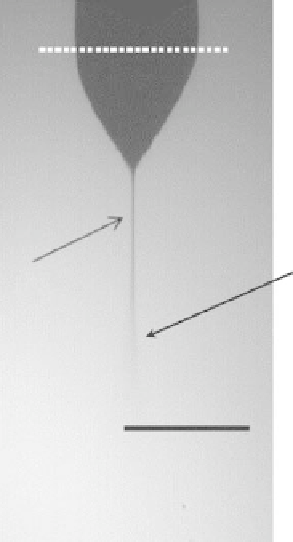Biomedical Engineering Reference
In-Depth Information
Break up
Jet
400
µ
m
FIGURE 11.56
An image of stable cone-jet electrospraying for aerosolizing aspirin solution. (Reprinted
from Li, S.W., Jayasinghe, S.N., and Edirisinghe, M.J.,
Chem. Eng. Sci.
, 61, 3091, 2006. © Elsevier Science.
With permission.)
FIGURE 11.57
SEM image of aspirin relics aerosolized using electrospraying. (Reprinted from Li,
S.W., Jayasinghe, S.N., and Edirisinghe, M.J.,
Chem. Eng. Sci.
, 61, 3091, 2006. © Elsevier Science. With
permission.)
Eagles et al. employed electrospraying also to aerosolize the mouse neuronal cells [113]. The
research explored the feasibility of atomizing the neuronal cell suspension into fi ne droplets,
because the patterns of these cells would enable studies on neuronal networking, interactions, and
biochemical communications to be initiated. The Cath.a-differentiated (CAD) cell was chosen
as a model biomaterial, because it can differentiate and behave like a primary neuron when it is
deprived of serum. CAD cells were grown for 96 h in 100 mL of Dulbecco's modifi ed Eagle's
medium (DMEM) /Ham's F-12 growth medium with 10% (v/v) fetal-calf serum in an incubator at
37°C and 4% (v/v) CO
2
. The cell viability was assessed by staining cells with Trypan Blue. They



